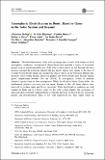Files in this item
Atmospheric electrification in dusty, reactive gases in the solar system and beyond
Item metadata
| dc.contributor.author | Helling, Christiane | |
| dc.contributor.author | Harrison, R. Giles | |
| dc.contributor.author | Honary, Farideh | |
| dc.contributor.author | Diver, Declan A. | |
| dc.contributor.author | Aplin, Karen | |
| dc.contributor.author | Dobbs-Dixon, Ian | |
| dc.contributor.author | Ebert, Ute | |
| dc.contributor.author | Inutsuka, Shu-ichiro | |
| dc.contributor.author | Gordillo-Vazquez, Francisco J. | |
| dc.contributor.author | Littlefair, Stuart | |
| dc.date.accessioned | 2016-04-28T08:30:03Z | |
| dc.date.available | 2016-04-28T08:30:03Z | |
| dc.date.issued | 2016-07 | |
| dc.identifier | 241205343 | |
| dc.identifier | 21cfee79-7e3d-4711-87b8-c9c7ea7d5c95 | |
| dc.identifier | 84977119977 | |
| dc.identifier | 000379016200001 | |
| dc.identifier.citation | Helling , C , Harrison , R G , Honary , F , Diver , D A , Aplin , K , Dobbs-Dixon , I , Ebert , U , Inutsuka , S , Gordillo-Vazquez , F J & Littlefair , S 2016 , ' Atmospheric electrification in dusty, reactive gases in the solar system and beyond ' , Surveys in Geophysics , vol. 37 , no. 4 , pp. 705-756 . https://doi.org/10.1007/s10712-016-9361-7 | en |
| dc.identifier.issn | 0169-3298 | |
| dc.identifier.uri | https://hdl.handle.net/10023/8689 | |
| dc.description | ChH highlight financial support of the European Community under the FP7 by an ERC starting Grant 25743. DAD gratefully acknowledges support from EPSRC via Grant Numbers EP/K006142/1 and EP/K006088/1. FJGV thanks the Spanish Ministry of Economy and Competitiveness (MINECO) under projects FIS2014-61774-EXP and ESP2013-48032-C5-5-R and the EU through the FEDER programme. | en |
| dc.description.abstract | Detailed observations of the solar system planets reveal a wide variety of local atmospheric conditions. Astronomical observations have revealed a variety of extrasolar planets none of which resembles any of the solar system planets in full. Instead, the most massive amongst the extrasolar planets, the gas giants, appear very similar to the class of (young) brown dwarfs which are amongst the oldest objects in the universe. Despite this diversity, solar system planets, extrasolar planets and brown dwarfs have broadly similar global temperatures between 300 and 2500 K. In consequence, clouds of different chemical species form in their atmospheres. While the details of these clouds differ, the fundamental physical processes are the same. Further to this, all these objects were observed to produce radio and X-ray emission. While both kinds of radiation are well studied on Earth and to a lesser extent on the solar system planets, the occurrence of emission that potentially originates from accelerated electrons on brown dwarfs, extrasolar planets and protoplanetary disks is not well understood yet. This paper offers an inter-disciplinary view on electrification processes and their feedback on their hosting environment in meteorology, volcanology, planetology and research on extrasolar planets and planet formation. | |
| dc.format.extent | 52 | |
| dc.format.extent | 3271321 | |
| dc.language.iso | eng | |
| dc.relation.ispartof | Surveys in Geophysics | en |
| dc.subject | Dust charging | en |
| dc.subject | Discharging | en |
| dc.subject | Solar system | en |
| dc.subject | Extrasolar planets | en |
| dc.subject | Moon | en |
| dc.subject | Asteroids | en |
| dc.subject | Electrification processes | en |
| dc.subject | Electrical phenomena | en |
| dc.subject | QC Physics | en |
| dc.subject.lcc | QC | en |
| dc.title | Atmospheric electrification in dusty, reactive gases in the solar system and beyond | en |
| dc.type | Journal item | en |
| dc.contributor.institution | University of St Andrews. School of Physics and Astronomy | en |
| dc.identifier.doi | 10.1007/s10712-016-9361-7 | |
| dc.description.status | Peer reviewed | en |
| dc.identifier.url | http://esoads.eso.org/abs/2016arXiv160104594H | en |
This item appears in the following Collection(s)
Items in the St Andrews Research Repository are protected by copyright, with all rights reserved, unless otherwise indicated.

